Quarantine
Side by Side Cages
Cage Within a Cage
Playtime Introductions
Car Ride Method
Smoosh Method
Side by Side Cages
Cage Within a Cage
Playtime Introductions
Car Ride Method
Smoosh Method
Chinchillas are very sociable animals. It is for this reason that two chinchillas can be better than one. Unfortunately, if the chinchillas are not introduced to each other properly, they may fight. Chinchillas are capable of inflicting severe injuries on each other and sometimes will fight to the death.
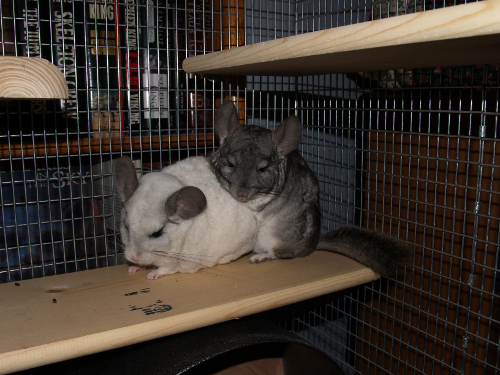 A mosaic and a standard grey chichilla
A mosaic and a standard grey chichillaQuarantine
If your chinchillas were not originally cage mates, (bought from different breeders or stores, or bought from the same breeder at different times) begin by quarantining your chinchillas in separate cages. Place each cage in a separate room. Do not allow them to interact with each other for 30 days. The quarantine is necessary to allow your new pet to become accustomed to the bacteria that are naturally present in their new environment. It also prevents the new chinchilla from possibly passing diseases on to the chinchillas already in the residence. If your chinchillas were already cage mates or came from the same breeder at the same time, quarantine will not be necessary. Once quarantine is over, the process of introducing the chinchillas can begin. Five methods exist for introducing chinchillas. They include side by side cages, cage within a cage, playtime introductions, car rides, and the smoosh method. There are pros and cons to each method.
Side by Side Cages
This method involves two cages. The first step in this method is to place the cages next to each other, spaced far enough apart that the chinchillas can not reach each other through the bars. The cages should remain next to each other for at least a week or two. At the end of this time, if the chinchillas appear to be getting along with each other, and are not barking or fighting through the bars, put a dab of vanilla on each chinchilla’s nose and just above their tails. Then place the bossier (more dominant) chinchilla in the other chinchilla’s cage. This should be done when sufficient time is available to watch the chinchillas constantly for the first couple of days. Keep an eye on the chinchillas and separate them if they begin fighting. Some chasing and dominance humping may occur. This is normal. Excessive fighting can and will include lots of chasing, pulling fur, barking and biting.
If fighting does occur, try switching cages, every day or two, without cleaning them. In this way, the chinchillas can get used to each other’s scent. After a week or so, try again. It can take months of trying before the chinchillas accept each other.
An additional step to this method is placing the chinchillas in a freshly cleaned cage that does not have the scent of either one, making sure that the shelves, houses, etc, are rearranged so that neither chinchilla feels the need to protect their territory. The pros for this method are that it gives plenty of time for the chinchillas to get to know each other and is usually fairly stress free. It does, however, require a good deal of time.
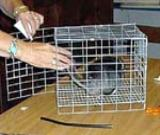 A chinchilla in a show cage
A chinchilla in a show cageThe cage within a cage method also involves two cages, the one in which the chinchillas will be living and a much smaller cage, preferably a show cage. The smaller cage needs to be small enough to fit inside the larger one and be open enough to allow the chinchillas to interact through the cage wire. Begin by placing the more dominant or aggressive chinchilla inside the small cage. Place the chinchilla, cage and all, inside the large cage. Put some hay on top of or in front of the small cage. This will force the loose chin to interact with the caged chin while it eats the hay. After several hours (or even overnight), switch the chinchillas, placing the loose chinchilla in the small cage and freeing the caged chinchilla. Give them more hay if needed. Again, wait several hours. Repeat this as many times as it takes for the chinchillas to stop fighting. Once the chinchillas stop fighting, release the animal in the small cage, while the other is still loose. If serious chasing, fur pulling or fighting occurs, place the more aggressive chinchilla in the small cage and start over. This can take up to 4 days to work. An advantage to this method is the short amount of time that is usually required. The drawback to this method is that the chinchillas can bite each others toes and noses.
Playtime Introductions
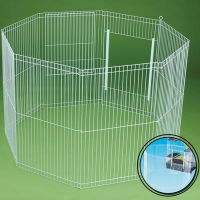
Car Ride Method
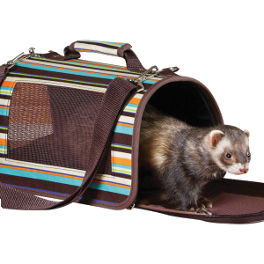 A small pet carrier
A small pet carrierSmoosh Method
Last is the smoosh method. This involves the use of a small cage, just barely big enough for both chinchillas to turn around and big enough for them to be able to crawl over each other to get to the other side. The chinchillas are placed in the cage at the same time. They are left in the cage for no more than fifteen minutes. Any longer can cause the chinchillas to overheat and a fight is sure to break out. Additionally, longer than fifteen minutes is cruel. Once the fifteen minutes is up, remove the chinchillas from the cage, put a dab of vanilla on each chinchilla’s nose and just above their tails and place them in a clean, neutral cage. As always, keep a close eye on the chinchillas for several days to watch for signs of fighting. Again, as with the car ride method, this one is quick, but the chins can be fine at first and later decide to fight.
With all of these methods, it is best to supply each chinchilla with a place to hide from the other chinchilla. The hides can be houses, tunnels or tubes or any combination of them. It is also wise to supply two of everything in the cage. Two houses, two tunnels, two food bowls and two water bottles. This will help if one of the chinchillas bullies the other and does not allow him access to these items. More information on bullying can be found in the section on dominance.
Often, if one method does not work, a different method can be tried and used successfully. Other times, two chinchillas will not like each other no matter what you do. In this case, do not force the issue. The choices in this situation are either housing them in separate cages, finding a new home for one, or returning one of the chinchillas (if the breeder or pet shop will allow this). A sure sign that the chinchillas need to be permanently separated is injury. Any time a chinchilla draws blood, it should be permanently separated from the chinchilla it attacked. Sometimes, the attacker can be paired with a different chinchilla, but often, this is not the case and the attacker will need to remain a single chinchilla. Keep in mind, chinchillas can change their minds at any time and decide they no longer like each other. Pairs that have been together for years can suddenly turn on each other. It is for this reason that chinchilla owners should always have a spare cage on hand.
Return to top



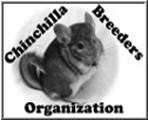 Site Last Updated on December 31, 1969 05:00 pm
Site Last Updated on December 31, 1969 05:00 pm